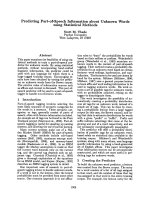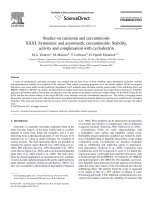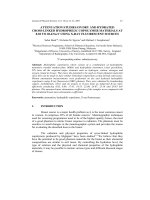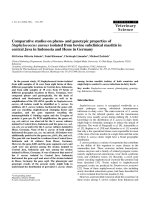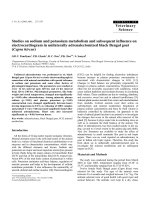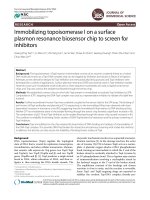QSAR studies on PIM1 and PIM2 inhibitors using statistical methods: A rustic strategy to screen for 5-(1H-indol-5-yl)-1,3,4-thiadiazol analogues and predict their PIM inhibitory activity
Bạn đang xem bản rút gọn của tài liệu. Xem và tải ngay bản đầy đủ của tài liệu tại đây (1.06 MB, 10 trang )
Aouidate et al. Chemistry Central Journal (2017) 11:41
DOI 10.1186/s13065-017-0269-1
RESEARCH ARTICLE
Open Access
QSAR studies on PIM1
and PIM2 inhibitors using statistical
methods: a rustic strategy to screen
for 5‑(1H‑indol‑5‑yl)‑1,3,4‑thiadiazol analogues
and predict their PIM inhibitory activity
Adnane Aouidate*, Adib Ghaleb, Mounir Ghamali, Samir Chtita, M’barek Choukrad, Abdelouahid Sbai,
Mohammed Bouachrine and Tahar Lakhlifi
Abstract
Background: Quantitative structure activity relationship was carried out to study a series of PIM1 and PIM2 inhibitors. The present study was performed on twenty-five substituted 5-(1H-indol-5-yl)-1,3,4-thiadiazols as PIM1 and PIM2
inhibitors having pIC50 ranging from 5.55 to 9 µM and from 4.66 to 8.22 µM, respectively, using genetic function algorithm for variable selection and multiple linear regression analysis (MLR) to establish unambiguous and simple QSAR
models based on topological molecular descriptors.
Results: Results showed that the MLR predict activity in a satisfactory manner for both activities. Consequently, the
aim of the current study is twofold, first, a simple linear QSAR model was developed, which could be easily handled
by chemist to screen chemical databases, or design for new potent PIM1 and PIM2 inhibitors. Second, the outcomes
extracted from the current study were exploited to predict the PIM inhibitory activity of some studied compound
analogues.
Conclusions: The goal of this study is to develop easy and convenient QSAR model could be handled by everyone to
screen chemical databases or to design newly PIM1 and PIM2 inhibitors derived from 5-(1H-indol-5-yl)-1,3,4-thiadiazol.
Keywords: PIM1, PIM2, 5-(1H-indol-5-yl)-1,3,4-thiadiazol-2-amines, QSAR model
Background
PIM1, PIM2 and PIM3 (proviral integration site for
moloney murine leukaemia virus) kinases form a threemember subgroup of serine/threonine kinases family, which share a high level of sequence homology and
exhibit some functional redundancy. They attracted
recent attention for their potential role in tumorigenesis,
tumor cell survival and resistance to antitumor agents,
thus, these findings make them an attractive target for
cancer therapy [1, 2].
*Correspondence:
MCNSL, School of Sciences, University Moulay Ismail, Meknes, Morocco
In the literature, several classes of molecules as pyrazines [3], cinnamic acid [4] and pyrrolo carbazole [5]
have been designed and synthesized to be able to inhibit
the PIM1 and PIM2 as well as to exhibit an anticancer activity, and they have been studied with different
approaches so far, but this way is regarded as time consuming and very costly. Hence, in order to reduce time
and cost also, to design more potent PIM inhibitors,
theoretical research can circumvent these difficulties
and allow obtaining precise data while taking advantage
of the rapid progress of computing chemical descriptors,
which can be obtained easily from publicly available software and servers. Therefore, developing predictive quantitative structure activity relationship (QSAR) models to
© The Author(s) 2017. This article is distributed under the terms of the Creative Commons Attribution 4.0 International License
( which permits unrestricted use, distribution, and reproduction in any medium,
provided you give appropriate credit to the original author(s) and the source, provide a link to the Creative Commons license,
and indicate if changes were made. The Creative Commons Public Domain Dedication waiver ( />publicdomain/zero/1.0/) applies to the data made available in this article, unless otherwise stated.
Aouidate et al. Chemistry Central Journal (2017) 11:41
predict the activity of new synthesized or designed PIM
inhibitors is highly desired.
In this context, the QSAR of thiadiazoles still receives
considerable attention because these agents represent a
large family of multi-biological activity substances and
continue to be a source of new drugs as witnessed over
recent decades. Thus, it is important to extend these findings with all available data. Recently, a series of some
potent PIM1 and PIM2 inhibitors have been designed
and reported by Bin Wu and al. [6]. To the best of our
knowledge, no QSAR studies have been carried out based
on the reported activities of this series. That prompted us
to aim an in silico study based on it, as well as to generalize beyond the data to screen and predict inhibitory
activity of other analogues molecules.
Quantitative structure–activity relationship (QSAR) has
been widely used last years in drug discovery and drug
design by medicinal chemists [7, 8] and in various practical applications [9, 10] to provide quantitative analysis
of structure and biological activity relationships of compounds. Different QSAR studies were reported to identify
important structural features responsible for the biological activity and to develop predictive models for diverse
chemicals by different authors [11, 12]. Thus, it becomes
necessary to develop a QSAR model for the prediction of
activity before synthesis of new PIM1 and PIM2 inhibitors. Because, a successful QSAR model is not only helps
to understand relationships between the physicochemical properties and biological activity of any class of molecules, but also provides researchers a deep analysis about
the lead molecules to be used in further studies [13].
Therefore, the current research aims to derive highly
correlation models, which explain the relationship
between the anticancer activity, and the structure of
twenty-five compounds based on physicochemical
descriptors using several chemometric methods such as
genetic function algorithm GFA, multiple linear regression MLR. Consequently, the principal goal of this work
is to develop easy and convenient QSAR model could be
handled by everyone for screening or designing newly
PIM1 and PIM2 inhibitors derived from thiadiazoles.
Methods
PIM1 and PIM2 inhibitory activities of a series of twentyfive of 5-(1H-indol-5-yl)-1,3,4-thiadiazol-2-amine derivatives were taken from literature [6] each activity was
expressed as IC50 (µM) then was converted to pIC50 as
pIC50 = −log IC50. Figure 1 and Table 1 show the substituted structures of the studied compounds. For modeling
purpose, the data set was split into two sets. Nineteen
molecules were randomly chosen to build the quantitative model (training set), and the remaining molecules
Page 2 of 10
HN
R1
R2
Fig. 1 The chemical structure of the studied compounds
were used to test the performance of the established
model (test set) for both activities. Additionally leaveone-out protocol and Y-randomization were carried out
to study the stability of the chosen training sets.
Molecular descriptors
All modeling studies were performed using the SYBYLX 2.0 molecular modeling package (Tripos Inc., St.
Louis, USA) running on a windows 7, 32 bits workstation. Three-dimensional structures were built using
the SKETCH option in SYBYL. All compounds were
minimized under the Tripos standard force field [14]
with Gasteiger-Hückel atomic partial charges [15] by
the Powell method with a convergence criterion of
0.01 kcal/mol Å. To describe the compound structural
diversity and in order to obtain validated QSAR models,
the optimized structures were saved in sdf format and
transferred to PaDEL server [16] to calculate topological descriptors encode the chemical properties of each
compound. Among the calculated descriptors only three
descriptors have been chosen as relevant to describe each
studied inhibitory activity (Table 2).
Methodology
After the calculation of all descriptors from PaDEL
server, a genetic function algorithm (GFA) analysis for
variable selection was applied on the molecular descriptors’ set to choose only the appropriate ones to describe
each activity [17]. Subsequently, the number was reduced
to three, which is reasonable considering the number of
molecules used to build the models according to the rule
of five [18]. Then, those three chosen descriptors were
used as input to perform an MLR study on each activity until a valid model including: the critical probability
p value <0.05 for all descriptors and for the complete
model, the Fisher criterion, the determination coefficient, the mean squared error, the multi-colinearity test,
and the internal, external validations, in addition to the
Y-randomization. Later, those descriptors were also
exploited to generate the applicability domain to describe
the chemical space for each model.
Aouidate et al. Chemistry Central Journal (2017) 11:41
Page 3 of 10
Table 1 Chemical structures and anti-cancer activities of substituted 5-(1H-indol-5-yl)-1,3,4-thiadiazol-2-amine derivatives
No
R1
1a
R2
N
H2N
S
pIC50
pIC50
PIM1
PIM2
6.505
5.567
No
R1
14
N
N
N
2
b
N
H2N
N
6.787
S
HN
N
S
H2N
6.565
5.788
5.548
4.658
17
N
6.458
H2N
18
H2N
O
N
N
PIM2
8.301
7.921
8.699
8.000
9.000
8.222
8.397
7.745
7.769
7.658
8.154
8.000
7.823
7.387
7.387
6.943
7.677
7.553
8.096
7.770
7.958
7.602
6.581
5.889
N
S
N
PIM1
N
S
N
N
pIC50
N
S
N
pIC50
N
S
H2N
N
HN
6.752
H2N
N
N
HN
S
N
N
16
N
S
N
15
N
N
F
5.996
HN
S
S
5a
N
N
N
N
4
H2N
O
N
3
R2
N
F
6b
H2N
H2N
S
N
N
7
H2N
N
N
8a
H2N
N
19
H2N
O
7.318
6.983
H2N
O
7.795
7.229
S
N
20
N
S
N
N
S
N
21
N
H2N
N
S
N
N
O
9a,b
H2N
N
O
N
S
7.619
7.432
N
N
22b
N
H2N
N
S
N
N
10
H2N
N
H
b
H2N
N
H
12
N
H2N
H2N
N
13
N
N
H
N
H2N
7.678
23a,b
N
O
6.962
6.644
24
H2N
N
N
a
N
H2N
6.847
6.717
N
25
H2N
O
7.958
7.377
N
Are the test sets for PIM1 and PIM2 inhibitory activities respectively
N
S
N
N
N
S
N
N
N
S
N
S
N
7.920
N
N
O
S
N
O
N
S
N
N
N
S
N
N
11
a, b
6.010
N
S
N
6.063
N
N
Aouidate et al. Chemistry Central Journal (2017) 11:41
Table 2 The three relevant molecular descriptors used
in each best QSAR model for each activity
Page 4 of 10
Selected descriptors for PIM1
inhibitory activity
Selected descriptors for PIM2
inhibitory activity
AATS0p
Autocorrelation
GATS8v
maxHBint8
Atom type electrotopo- AATS3i
logical state
Autocorrelation
after every iteration, a new QSAR model is developed.
The new QSAR models are expected to have lower Q
2
2
and R values than those of the original models. This
technique is carried out to eliminate the possibility of
the chance correlation. If higher values of the Q
2 and R2
are obtained, it means that an acceptable QSAR cannot
be generated for this data set because of the structural
redundancy and chance correlation.
GATS8v
Geary autocorrelation of VR1_Dzm
lag 8 weighted by van
der Waals volume
Barysz matrix
Results and discussion
Geary autocorrelation
of lag 8 weighted by
van der Waals volume
Statistical analysis
In the present study XLSTAT version 2013 [19] was used to
perform multiple linear regression (MLR), which is a statistical method aimed to establish a mathematical relationship
between a property of a given system and a set of molecular descriptors that encode chemical information. A genetic
function algorithm tool was used for variables selection
[17], which is a mathematical technique served to reduce
the number of variables used in the data set, as well as to
select only the pertinent ones, in which mutation probability was 0.5 the smoothing parameter was 1.0, and cross over
probability was 1.0. GFA in this study serves to select significant molecular descriptors from vast number of variables.
Validation
The main objective of a QSAR study is to obtain a model
with the highest predictive and generalization abilities.
Therefore, two principals (internal validation and external
validation) were carried out in order to evaluate the predictive power of the developed QSAR models. For the internal
validation, the leave-one-out cross-validation process (Q2)
was used to evaluate the stability and the internal capability of the proposed models in the present study. A high Q2
value means a high internal predictive power of a QSAR
model and a good robustness. Nevertheless, the study
of Globarikh [20] indicated that there is no correlation
between the value of Q2 for the training set and predictive
ability of the test set, revealing that the Q
2 is still inadequate
for a reliable estimate of model predictive power for all
new chemicals. Thus, the external validation regards the
only way to determine both the generalizability and the
true predictive power of QSAR models for new chemicals.
For this reason, the statistical external validation process
was applied to the developed models using a test set as
described by Globarikh and Tropsha; Roy and Roy [20–22].
Y‑randomization test
The obtained models were further validated by the
Y-Randomization method [23]. In which the dependent vector (pIC50) is randomly shuffled many times and
Data set for analysis
A QSAR study was carried out for the first time on
twenty-five of 5-(1H-indol-5-yl)-1,3,4-thiadiazol-2-amine
derivatives, in order to establish quantitative relationships between their structures and their PIM1 and PIM2
inhibitory activities. The three selected descriptors for
each model are shown in Table 2.
Multiple linear regressions MLR
Based on the selected molecular descriptors two mathematical linear models were proposed to predict quantitatively the physicochemical effects of substituents on the
PIM1 and PIM2 inhibitory activities using linear regression. In total, nineteen molecules were placed in the
training set to build the QSAR models, and the six molecules composed the test set,
n
Y = a0 +
ai xi .
i=1
For the PIM1 inhibitory activity the best linear model
contains three molecular descriptors: GATS8v, AATS0p
and maxHBint8 and it is represented by the following
equation:
pIC50 = 6.92 − 5.84 × (AATS0p) − 0.27 × (maxHBint8)
(1)
+ 1072 × (GATS8v)
2
2
N = 19, R = 0.87, R = 0.726, Q = 0.60, MSE = 0.221,
F = 16.04, P < 0.0001.
For the PIM2 inhibitory activity the best linear model
contains three molecular descriptors: GATS8v, AATS3i
and VR1_Dzm and it is represented by the following
equation:
pIC50 = −32.31 + 12.8 × (GATS8v) + 0.16
× (AATS3i) − 8.48 × (VR1_Dzm)
2
2
(2)
N = 19, R = 0.91, R = 0.825, Q = 0.73, MSE = 0.184,
F = 23.85, P < 0.0001.
R2 is the coefficient of determination, F is the Fisher
statistic and MSE is the mean squared error. Higher
coefficient of determination and lower mean squared
error indicate that the model is more reliable. A P
smaller than 0.05 means that the obtained equation is
Aouidate et al. Chemistry Central Journal (2017) 11:41
Page 5 of 10
statistically significant at the 95% level. The obtained
model were cross-validated by their applicable Q
2 values
2
(Q = 0.60 and 0.73) respectively, using the leave-oneout (LOO) method. A value of Q
2 greater than 0.5 is the
basic criteria to qualify a model as valid [20].
The multi-collinearity between the above three
descriptors for each model was detected by calculating
their variation inflation factors VIF as shown in Table 3.
Accordingly, it has been found that the descriptors used
in the proposed models have very low-inter-correlation.
The VIF [24] was defined as 1/(1−R2), where R is the
coefficient of correlation between one descriptor and all
the other descriptors in the proposed model. A VIF value
greater than 5.0 indicates that the model is unstable;
a value between 1.0 and 4.0 indicates that the model is
acceptable.
The correlations of the predicted and observed activities are illustrated in Fig. 2. The descriptors proposed
in Eqs. (1) and (2) by MLR are then used as the input
parameters to generate the applicability domains (AD)
for both models.
Applicability domain
The utility of a QSAR model is its accurate prediction
ability for new chemical compounds. So, once the QSAR
model is built, its domain of applicability (AD) must be
defined. A model is regarded valid only within its training domain and only the prediction for new compounds
falling within its applicability domain can be considered
reliable and not model extrapolations. The most common
method to define the AD, it is based on the determination of the leverage value of each compound [22]. The
Williams plot [the plot of standardized residuals versus
leverage values (h)] is used in the present study to visualize the AD of the QSAR model.
hi = xiT (X T X)−1 xi
where the xi is the descriptor vector of the considered
compound, X is the descriptor matrix derived from the
training set descriptor values, the threshold is defined as:
h∗ =
3(k + 1)
n
Table 3 Multi-colinearity test
Variables
PIM1 inhibitory activity
VIF
PIM2 inhibitory activity
AATS0p
maxHBint8
GATS8v
GATS8v
AATS3i
VR1_Dzm
2.376
2.343
2.081
1.810
1.960
1.168
9
Pred(pIC50 PIM 1) / pIC50
9
Pred(pIC50 PIM 2 ) / pIC50
pIC50
8
pIC50
8
7
7
6
6
5
Pred(pIC50)
5
5
6
7
Pred(pIC50)
8
9
4
4
5
6
7
Fig. 2 Correlations of observed and predicted activities (training set in black and test set in red) values calculated using MLR models
8
9
Aouidate et al. Chemistry Central Journal (2017) 11:41
where n is the number of compound in the training set, k
is the number of the descriptors in the proposed model, a
leverage (h) greater than the threshold (h*) indicates that
the predicted response is an extrapolation of the model
and, consequently, it can be unreliable.
The Williams plots of the presented MLR models are
shown in Figs. 3 and 4, the applicability domains are
established inside a squared area within ±2 standard
deviation and a leverage threshold h* of 0.63 for both
models.
As shown in the developed Williams plot on the
selected descriptors for predicting the PIM1 inhibitory
activity the majority of compounds from the data set are
in this area, except one (compound 4) from training set
exceeds the threshold and it is considered as an outlier
compound. This erroneous prediction could probably be
attributed to the presence of sulfur on the R
1 substituent
whereas; the majority of compounds have an NH at this
position.
While for the developed Williams plot on the selected
descriptors for predicting the PIM2 inhibitory activity
the majority of compounds from the data set are fallen
within the AD, except two molecules: (compound 2) in
training set exceeds the threshold, so, it is considered
as an outlier compound. Here, this erroneous prediction could probably be attributed to the unsubstituted R2
whereas; the majority of compounds are substituted at
this position.
Y‑randomization
The Y-randomization method was carried out to validate
the MLR models. Several random shuffles of the dependent variable
(pIC50) were performed then after every
shuffle, a QSAR was developed and the obtained results
are shown in Table 4. The low Q2 and R2 values obtained
after every shuffle indicate that the good result in our
Page 6 of 10
Fig. 4 Williams plot for the training set and external validation for the
PIM2 inhibitory activity of compounds, listed in Table 1 (h* = 0.63 and
residual limits ±2)
Table 4 Q2 and R2 values after several Y-randomization
tests
Iteration
MLR (PIM1)
Q
1
2
3
4
5
6
7
8
9
10
2
MLR(PIM2)
2
Q2
R
−0.12
−0.32
−0.60
−0.27
−0.19
−0.53
−0.34
−1.59
−0.77
−0.19
0.32
R2
−0.48
0.09
−0.09
0.09
−0.14
0.24
0.26
0.82
0.03
0.33
0.24
0.12
0.31
0.07
0.21
0.43
0.09
0.11
0.45
0.19
0.12
0.48
0.20
0.09
0.54
0.23
0.20
0.17
0.29
original MLR models are not due to a chance correlation
of the training set.
External validation
To test the prediction ability of the obtained MLR models, it is required the use of a test set for external validation. As long as, the models generated on the training set
using 19 of 5-(1H-indol-5-yl)-1,3,4-thiadiazol-2-amine
derivatives were used to predict the PIM1 and PIM2
inhibitory activities of the remaining molecules. The
parameters of the performance of the generated models
Table 5 The statistical results of MLR models with validation techniques
Method/parameter
Fig. 3 Williams plot for the training set and external validation for the
PIM1 inhibitory activity of compounds, listed in Table 1 (h* = 0.63 and
residual limits ±2)
R
R2
Q2
R2 test
MSE
MLR(PIM1)
0.87
0.726
0.60
0.84
0.222
MLR(PIM2)
0.91
0.825
0.73
0.74
0.184
Aouidate et al. Chemistry Central Journal (2017) 11:41
Page 7 of 10
Table 6 Predicted values and calculated h of pIC50 (µM) according to different methods
Compound
Molecular structure
Pubchem CID
Pred (PIC50) for PIM1
h
Pred (PIC50) for PIM2
h
1
68328588
7.782
0.122
7.455
0.213
2
45377352
10.367
0.906
9.497
1.117
3
68328129
7.316
0.352
7.243
0.162
4
68327929
8.332
0.102
7.513
0.330
5
68328158
8.311
0.074
7.072
1.109
6
68328259
8.434
0.113
7.958
0.106
7
68328426
8.347
0.089
8.026
0.151
8
68328539
8.137
0.387
6.699
0.111
9
68328547
8.282
0.1023
7.594
0.0964
10
68328676
8.138
0.0739
7.068
0.7669
Aouidate et al. Chemistry Central Journal (2017) 11:41
Page 8 of 10
Table 6 continued
Compound
Molecular structure
Pubchem CID
Pred (PIC50) for PIM1
h
Pred (PIC50) for PIM2
h
11
68328891
8.329
0.0860
8.244
0.2909
12
68356801
8.745
0.2543
8.137
0.9468
Screening of 5‑(1H‑indol‑5‑yl)‑1,3,4‑thiadiazol‑2‑amines
analogues and prediction of their PIM1 and PIM2
inhibitory activities
Overall, this study can be utilized to screen databases to
look for new PIM1 and PIM2 inhibitors as well as to predict their inhibitory activities. Therefore, the built models
were used to screen the Pubchem database, by searching compounds had 80% similarity with the most active
compound of the studied series (compound 16). Twelve
compound were gathered as shown in Table 6 and their
predicted values were calculated in addition to their leverages (h) to check if they fall in the AD of the proposed
models (Table 6; Figs. 5, 6).
For the proposed model to predict the PIM1 inhibitory activity, almost of the compounds have h < h*, so
their predicted values are regarded reliable except for
compound 45377352 which has a leverage exceeds the
threshold (h = 0.90).
While for the proposed model to predict the PIM2
inhibitory activity, it is found that among the twelve
chemicals, only four were found to have h > h*,
45377352, 68328158, 68328676 and 68356801 respectively, so, expect for those molecules, the PIM2 predicted
inhibitory activity of the eight remaining 5-(1H-indol5-yl)-1,3,4-thiadiazol analogues is regarded reliable.
Moreover, the 5-(1H-indol-5-yl)-1,3,4-thiadiazol analogues were analyzed for their various properties, Log
P, H-bond acceptor (H–A), H-bond donor (H–D), Polar
surface area (P.S) (A2), Rotatable Bonds (R.B) and Molecular weight (MW) (g/mol), results shown that they follow the Lipinski’s rule of five for oral bioavailability [25].
Therefore, there are regarded to be acceptable as lead
molecules to inhibit the PIM1 and PIM2 kinases.
Conclusions
To predict the PIM1 and PIM2 inhibitory activities of a
series substituted 5-(1H-indol-5-yl)-1,3,4-thiadiazol2-amines, linear technique was used to propose useful
mathematical models to establish quantitative relationships between them and a set of topological descriptors.
Both proposed linear models MLR exhibit high determination coefficients, good stabilities and prediction abilities, using only three descriptors for each model. Such as
the accuracy and predictability of the proposed models
were checked based on the domain of applicability (AD),
the Y-randomization and by comparing key statistical
indicators, such as the R or R
2 of the obtained models, as
shown in Table 7. To validate these results, a test set was
used, as shown in Table 5.
compound
are shown in Table 5. It can be seen clearly that the generated models are stable and predictable statically.
Both obtained models for predicting the PIM1 and
PIM2 inhibitory activities have high coefficients of determination for training (R2 = 0.726 and 0.825) and testing sets (test R
2 = 0.84 and 0.74) respectively. Also high
Cross-validation coefficients ( Q2 = 0.60 and 0.76). So the
proposed QSAR models can be used as primary step for
screening and designing newly PIM1 and PIM2 inhibitors derived from 5-(1H-indol-5-yl)-1,3,4-thiadiazol.
12
11
10
9
8
7
6
5
4
3
2
1
0
0.2
0.4
0.6
Leverage
0.8
1
Fig. 5 Leverage values of the screened compounds from pubchem
database for the PIM1 inhibitory activity, listed in Table 7 (h* = 0.63)
compound
Aouidate et al. Chemistry Central Journal (2017) 11:41
Page 9 of 10
each model on this series of compounds were used as primary step for predicting the PIM1 and PIM2 inhibitory
activity of 5-(1H-indol-5-yl)-1,3,4-thiadiazol analogues.
12
11
10
9
8
7
6
5
4
3
2
1
0
0.2
0.4
0.6
Leverage
0.8
1
1.2
Fig. 6 Leverage values of the screened compounds from the
pubchem database for the PIM2 inhibitory activity, listed in Table 7
(h* = 0.63)
Table 7 Observed values and calculated values of pIC50
according to different methods
No
pIC50 (obs)
pIC50 PIM1 (pred)
pIC50 PIM2 (pred)
MLR
MLR
Abbreviations
QSAR: quantitative structure activity relationship; PIM: proviral integration site
for moloney murine leukaemia virus kinases; MLR: multiple linear regression;
AD: applicability domain; GFA: genetic function algorithm; Q2: cross-validated
determination coefficient; N: optimum number of components obtained from
cross-validated PLS analysis and same used in final non-cross-validated analysis; R2: non-cross-validated correlation coefficient; MSE: standard error of the
estimate; F: F test value; text R2: external validation determination coefficient.
Authors’ contributions
AA proposed the work; AA carried out the QSAR studies, arranged the results
and drafted the manuscript under the guidance of MC, AS, MB and TL. AA and
AG, MG and SC did the manuscript revision and final shape. All authors read
and approved the final manuscript.
Acknowledgements
We are grateful to the “Association Marocaine des Chimistes Théoriciens”
(AMCT) for its pertinent help concerning the programs.
Competing interests
The authors declare that they have no competing interests.
Publisher’s Note
1a
5.567
6.781
6.161
2b
5.996
6.769
5.581
Springer Nature remains neutral with regard to jurisdictional claims in published maps and institutional affiliations.
3
5.787
6.744
4.604
4
4.657
5.440
6.154
Received: 2 April 2017 Accepted: 11 May 2017
5a
6.458
6.495
7.250
6b
6.010
6.708
7.455
7
6.983
7.793
6.373
8a
7.229
7.967
7.388
9
7.431
7.791
7.708
10
7.677
7.781
7.446
11b
6.644
7.996
8.308
12
6.717
6.622
7.265
13
7.376
7.870
7.252
14
7.920
8.049
7.379
15
8.000
7.844
7.016
16
8.221
8.398
7.487
17
7.744
8.148
7.039
18
7.657
7.638
7.186
19
8.000
8.000
7.334
20
7.387
7.756
6.475
21
6.943
7.965
7.206
22b
7.552
7.689
8.003
23a, b
7.769
8.524
8.223
24a
7.602
8.408
5.947
25
5.889
7.578
7.268
a, b
a, b
Are the test sets for PIM1 and PIM2 inhibitory activities respectively
Finally, we concluded that the topological descriptors
used are able to encode the structural features of the
studied compounds. Obviously, the obtained results from
References
1. Brault L, Gasser C, Bracher F et al (2010) PIM serine/threonine
kinases in the pathogenesis and therapy of hematologic malignancies and solid cancers. Haematologica 95:1004–1015. doi:10.3324/
haematol.2009.017079
2. Nawijn MC, Alendar A, Berns A (2011) For better or for worse: the role of
Pim oncogenes in tumorigenesis. Nat Rev Cancer 11:23–34. doi:10.1038/
nrc2986
3. Qian K, Lian W, Cywin CL et al (2009) Hit to lead account of the discovery
of a new class of inhibitors of pim kinases and crystallographic studies
revealing an unusual kinase binding mode. J Med Chem 52:1814–1827.
doi:10.1021/jm801242y
4. Schulz MN, Fanghänel J, Schäfer M et al (2011) A crystallographic
fragment screen identifies cinnamic acid derivatives as starting points
for potent Pim-1 inhibitors. Acta Crystallogr Sect D Biol Crystallogr
67:156–166. doi:10.1107/S0907444910054144
5. Gadewal N, Varma A (2012) Targeting Pim-1 kinase for potential drugdevelopment. Int J Comput Biol Drug Des 5:137–151. doi:10.1504/
IJCBDD.2012.048303
6. Wu B, Wang HL, Cee VJ et al (2015) Discovery of 5-(1H-indol-5-yl)-1,3,4thiadiazol-2-amines as potent PIM inhibitors. Bioorganic Med Chem Lett
25:775–780. doi:10.1016/j.bmcl.2014.12.091
7. González-Díaz H (2013) Computational prediction of drug-target interactions in medicinal chemistry. Curr Top Med Chem 13:1619–1621
8. González-Díaz H, Arrasate S, Sotomayor N et al (2013) MIANN models
in medicinal, physical and organic chemistry. Curr Top Med Chem
13:619–641
9. Abeijon P, Garcia-Mera X, Caamano O et al (2017) Multi-target mining
of Alzheimer disease proteome with Hansch’s QSBR-perturbation
theory and experimental-theoretic study of new thiophene isosters of
rasagiline. Curr Drug Targets 18:511–521. doi:10.2174/13894501166661
51102095243
Aouidate et al. Chemistry Central Journal (2017) 11:41
10. Todeschini R, Pazos A, Arrasate S, González-Díaz H (2016) Data analysis in
chemistry and bio-medical sciences. Int J Mol Sci 17:2105. doi:10.3390/
ijms17122105
11. González-Díaz H, Herrera-Ibatá DM, Duardo-Sánchez A et al (2014) ANN
multiscale model of anti-HIV drugs activity vs AIDS prevalence in the US
at county level based on information indices of molecular graphs and
social networks. J Chem Inf Model 54:744–755. doi:10.1021/ci400716y
12. Duardo-Sánchez A, Munteanu CR, Riera-Fernández P et al (2014) Modeling complex metabolic reactions, ecological systems, and financial
and legal networks with MIANN models based on Markov-Wiener node
descriptors. J Chem Inf Model 54:16–29. doi:10.1021/ci400280n
13. Gupta SP, Mathur AN, Nagappa AN et al (2003) A quantitative structureactivity relationship study on a novel class of calcium-entry blockers:
1-[(4-(aminoalkoxy)phenyl)sulphonyl]indolizines. Eur J Med Chem
38:867–873
14. Clark M, Cramer RD, Van Opdenbosch N (1989) Validation of the general
purpose tripos 5.2 force field. J Comput Chem 10:982–1012. doi:10.1002/
jcc.540100804
15. Purcell WP, Singer JA (1967) A brief review and table of semiempirical
parameters used in the Hueckel molecular orbital method. J Chem Eng
Data 12:235–246. doi:10.1021/je60033a020
16. Yap CW (2011) PaDEL-descriptor: an open source software to calculate
molecular descriptors and fingerprints. J Comput Chem 32:1466–1474.
doi:10.1002/jcc.21707
Page 10 of 10
17. Waller CL, Bradley MP (1999) Development and validation of a novel variable selection technique with application to multidimensional quantitative structure-activity relationship studies. J Chem Inf Model 39:345–355.
doi:10.1021/ci980405r
18. Hickey JP, Passino-reader DR (1991) Linear solvation energy relationships :
“Rules of Thumb” for estimation of variable values. Environ Sci Technol
25:1753–1760
19. XLSTAT
20. Golbraikh A, Tropsha A (2002) Beware of q
2! J Mol Graph Model 20:269–
276. doi:10.1016/S1093-3263(01)00123-1
21. Roy PP, Roy K (2008) On some aspects of variable selection for partial least
squares regression models. QSAR Comb Sci 27:302–313. doi:10.1002/
qsar.200710043
22. Gramatica P (2007) Principles of QSAR models validation: internal and
external. QSAR Comb Sci 26:694–701. doi:10.1002/qsar.200610151
23. Veerasamy R, Rajak H, Jain A et al (2011) Validation of QSAR models—strategies and importance. Int J Drug Des Disocov 2:511–519.
doi:10.1016/j.febslet.2005.06.031
24. O’Brien RM (2007) A caution regarding rules of thumb for variance inflation factors. Qual Quant 41:673–690. doi:10.1007/s11135-006-9018-6
25. Lipinski CA (2004) Lead- and drug-like compounds: the rule-of-five
revolution. Drug Discov Today Technol 1:337–341. doi:10.1016/j.
ddtec.2004.11.007

